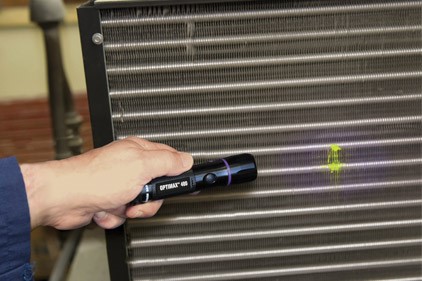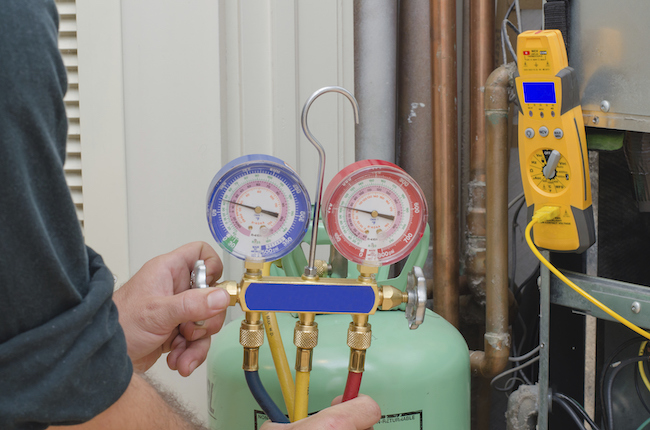To find a car AC leak without dye, use a UV light and an electronic leak detector. Finding a car AC leak without dye is possible by utilizing a UV light and an electronic leak detector.
These tools can help detect leaks in the AC system without the need for dye, which can be messy and time-consuming to use. By shining the UV light on potential leak areas and using the electronic leak detector to pinpoint the source of the leak, car owners can quickly and accurately identify the issue and address it accordingly.
This method provides a convenient and efficient way to locate AC leaks without the need for messy dyes.

Credit: www.youtube.com
Methods For Detecting Car Ac Leaks Without Dye
Finding a car AC leak can be quite a challenge, especially if you don’t want to use dye. Luckily, there are alternative methods that can help detect leaks without the need for messy dyes. In this article, we will explore three effective methods for detecting car AC leaks without dye: visual inspection, using an electronic leak detector, and using UV light. These methods can help you identify the source of the leak and get your car’s AC system back up and running in no time.
Visual Inspection
One of the simplest ways to detect a car AC leak is through a visual inspection. This method involves carefully examining the AC system components for any signs of oil or refrigerant residue. Start by inspecting the AC compressor, condenser, hoses, and fittings. Look for any oily or greasy stains, as well as bubbles or discoloration. These can be indicative of a leak. Pay special attention to areas where components are joined, as leaks often occur at these connection points.
If you spot any signs of a leak during your visual inspection, it’s important to address the issue as soon as possible. Ignoring a small leak can lead to bigger problems down the road and potentially expensive repairs. Consider bringing your car to a professional technician if you’re not confident in handling the repairs yourself.
Using An Electronic Leak Detector
Another effective method for detecting car AC leaks without dye is by using an electronic leak detector. These handheld devices are designed to detect the presence of refrigerant gases near a leak. They work by sensing the electrically charged ions that are emitted when refrigerant leaks from the system.
To use an electronic leak detector, start by ensuring that both the engine and AC system are turned off. Then, connect the detector to the low-pressure port on the AC system. Slowly move the detector’s sensing tip along the AC system components, paying close attention to connection points and areas prone to leaks. If there is a leak present, the detector will emit an audible alarm or display a visual indication.
It’s important to note that electronic leak detectors are highly sensitive and can detect even the smallest leaks. This makes them a valuable tool for pinpointing the exact location of a leak. However, they may not be as effective in detecting slow leaks or leaks in hard-to-reach areas. In such cases, using an alternative method may be necessary.
Using Uv Light
UV light is another useful method for detecting car AC leaks without the need for dye. This method involves adding a UV dye to the AC system, which will fluoresce under UV light if a leak is present. While technically not “dye-free,” it’s a non-messy alternative that can still help identify leaks.
To use UV light for leak detection, begin by adding the UV dye to the AC system following the manufacturer’s instructions. Run the AC system for a short period to circulate the dye. After allowing enough time for the dye to settle, use a UV light, also known as a blacklight, to inspect the AC system components. The dye will appear fluorescent under the UV light, making it easy to spot any leaks.
This method is particularly useful for detecting slow leaks or leaks in hard-to-reach areas. However, it’s important to keep in mind that UV light can only detect leaks where the dye has been added. Therefore, it’s crucial to ensure that the dye is added correctly and reaches all the relevant areas of the AC system.

Credit: www.controlairsystems.com
Step-by-step Guide To Detect Car Ac Leaks Without Dye
Are you experiencing poor cooling performance from your car’s air conditioning system? There’s a chance that your AC system may have a leak. While many mechanics use fluorescent dye to identify leaks, it’s not always necessary. In this step-by-step guide, we’ll show you how to detect car AC leaks without dye. By following these simple techniques, you can save time and money by locating the leak yourself. Let’s get started!
Preparation
Before you begin the leak detection process, it’s important to gather the necessary tools and prepare the area.
- Make sure your car is parked in a well-ventilated area.
- Gather the following tools:
| 1. Electronic leak detector |
| 2. UV light with yellow glasses |
| 3. Safety gloves |
| 4. Safety goggles |
| 5. A rag or towel |
Visual Inspection
The first step in detecting a car AC leak is to visually inspect the system for any obvious signs of leakage.
- Start by examining the AC compressor, located at the front of the engine compartment. Look for oily residue around the fittings and connections.
- Check the AC hoses for signs of wear, cracks, or loose connections.
- Inspect the AC condenser, located in front of the radiator. Look for oily spots or traces of refrigerant.
- Examine the AC evaporator, which is usually located behind the dashboard. Inspect for any signs of leakage.
If you notice any oily residue, traces of refrigerant, or signs of wear, it’s likely that you have a leak. However, a visual inspection alone may not always pinpoint the exact source of the leak.
Using An Electronic Leak Detector
An electronic leak detector is a highly effective tool that can help locate AC leaks quickly and accurately.
- Put on your safety gloves and goggles to protect yourself from refrigerant exposure.
- Turn on the electronic leak detector and hold it close to the AC system components.
- Slowly move the detector along the fittings, hoses, and connections, paying extra attention to areas where leaks are more likely to occur.
- If the detector alerts you with a beep or lights up, there is a leak in that area. Make sure to mark the spot for further inspection.
- Repeat this process for all the AC system components.
Using Uv Light
Another method to detect AC leaks is by using a UV light and fluorescent leak detection dye.
- Put on the yellow glasses to enhance the visibility of the dye.
- Start the car and turn on the AC system to its maximum cooling setting.
- Inject the fluorescent dye into the AC system following the manufacturer’s instructions.
- Use the UV light to scan the AC system components, including the fittings, hoses, connections, compressor, condenser, and evaporator.
- If the dye is present, it will fluoresce under the UV light, indicating the location of the leak.
Additional Tips And Precautions
Here are a few additional tips and precautions to keep in mind while detecting car AC leaks:
- Always handle refrigerant and AC system components with care.
- Ensure proper ventilation in the area to avoid inhaling any harmful fumes.
- Consult your car’s manual or seek professional help if you’re unsure about any step.
- If you’re unable to locate the leak using these methods, it’s advisable to consult a trained AC technician.
By following this step-by-step guide, you can successfully detect car AC leaks without the need for dye. Remember to take all necessary safety precautions and seek professional help if needed. Locating and fixing the leak quickly will help restore your car’s cooling performance and keep you comfortable on the road. Stay cool!

Credit: www.amazon.com
Conclusion
By following the steps outlined in this guide, you can easily find a car AC leak without the need for dye. By using simple tools such as a UV light and an electronic leak detector, you can detect and fix the leaks to ensure your car’s air conditioning system is working efficiently.
Keep in mind that regular maintenance and regular checks can prevent future AC leaks and save you from expensive repairs in the long run. Stay proactive and enjoy a cool and comfortable ride all year round!

